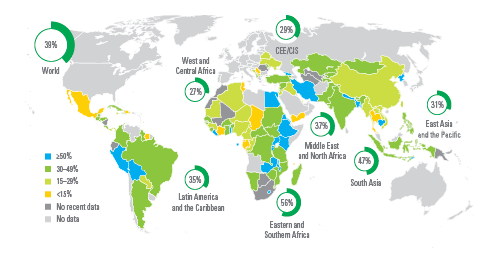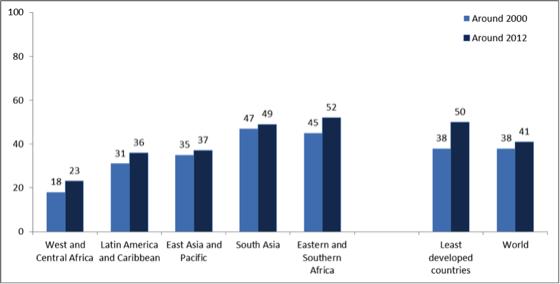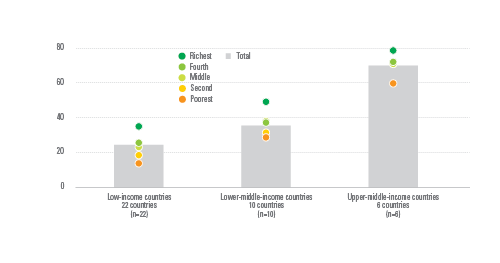Proper feeding of infants and young children can increase their chances of survival. It can also promote optimal growth and development, especially in the critical window from birth to 2 years of age. Ideally, infants should be breastfed within one hour of birth, breastfed exclusively for the first six months of life and continue to be breastfed up to 2 years of age and beyond. Starting at 6 months, breastfeeding should be combined with safe, age-appropriate feeding of solid, semi-solid and soft foods.
An infant that is not exclusively breastfed could be at a substantially greater risk of death from diarrhea or pneumonia than one who is. Moreover, breastfeeding supports infants’ immune systems and may protect them later in life from chronic conditions such as obesity and diabetes. In addition, breastfeeding protects mothers against certain types of cancer and other health conditions. Adequate feeding from 6 months onwards can prevent undernutrition and decrease the risk of infectious diseases, such as diarrhoea and pneumonia. Yet despite all the potential benefits, only about two fifths of infants worldwide are exclusively breastfed for the first six months of life, and only around two thirds are introduced to solid foods in a timely manner.

Improving Child Nutrition: The achievable imperative for global progress
This report builds on earlier findings on the impact of undernutrition by highlighting new developments and demonstrating that efforts to scale up nutrition programmes are working, benefiting children in many countries.
THE INDICATORS
The standard indicators for infant and young child feeding practices were developed in alignment with WHO’s Guiding Principles on feeding the breastfed and non-breastfed child. The aim is to use the guidelines to assess infant and young child feeding practices within and across countries and to evaluate progress in this programme area. While it is not possible to develop standard indicators for all desirable and recommended practices, 15 indicators (8 core and 7 optional) were developed and are presented in WHO’s 2008 publication, Indicators for Assessing Infant and Young Child Feeding Practices. Part 1: Definitions. These indicators are a culmination of six years of inter-agency work and are used to assess a subset of practices.
This set of indicators provides i) an update of the 1991 WHO and UNICEF indicators on breastfeeding practices and ii) a broad set of indicators[2] to assess, for the first time, feeding practices in children aged 6 to 23 months.
Core indicators for infant and young child feeding practices
|
Indicator name |
Definition |
UNICEF global database exists? |
|
|---|---|---|---|
|
Numerator |
Denominator |
||
|
Early initiation of breastfeeding |
Children born in the last 24 months who were put to the breast within one hour of birth |
Children born in the last 24 months |
Yes |
|
Exclusive breastfeeding |
Infants 0─5 months of age who received only breast milk during the previous day |
Infants 0─5 months of age |
Yes |
|
Continued breastfeeding at 1 year[3] |
Children 12─15 months of age who received breast milk during the previous day |
Children 12─15 months of age |
Yes |
|
Introduction of solid, semi-solid or soft foods |
Infants 6─8 months of age who received solid, semi-solid and soft foods during the previous day |
Infants 6─8 months of age |
Yes |
|
Minimum dietary diversity |
Children 6─23 months of age who received foods from ≥ 4 food groups during the previous day |
Children 6─23 months of age |
Coming in the State of the World’s Children 2015 report |
|
Minimum meal frequency |
Breastfed children 6─23 months of age who received solid, semi-solid and soft foods the minimum number of times or more during the previous day |
Breastfed children 6─23 months of age |
Coming in the State of the World’s Children 2015 report |
|
Non-breastfed children 6─23 months of age who received solid, semi-solid and soft foods or milk feeds the minimum number of times or more during the previous day |
Non-breastfed children 6─23 months of age |
||
|
Minimum acceptable diet |
Breastfed children 6─23 months of age who had at least the minimum dietary diversity and the minimum meal frequency during the previous day |
Breastfed children 6─23 months of age |
Coming in the State of the World’s Children 2015 report |
|
Non-breastfed children 6─23 months of age who received at least two milk feedings and had at least the minimum dietary diversity not including milk feeds and the minimum meal frequency during the previous day |
Non-breastfed children 6─23 months of age |
||
|
Consumption of iron-rich or iron-fortified foods |
Children 6─23 months of age who received an iron-rich food or a food that was specially designed for infants and young children and was fortified with iron, or a food that was fortified in the home with a product that included iron during the previous day |
Children 6─23 months of age |
No |
DATA COLLECTION AND REPORTING
Data for these indicators are collected though household surveys. With the exception of early initiation of breastfeeding, they are based on questions about liquid and food intake of children aged 0─23 months in the 24 hours preceding the survey. Standard questions and other practical methodological instructions for the core and optional indicators are available in the WHO document, Indicators for Assessing Infant and Young Child Feeding Practices. Part 2: Measurement. Large household survey programmes, such as MICS and DHS, are major sources of country-level estimates for seven of the core indicators as well as a subset of the optional indicators. Other national household surveys, such as national nutrition surveys, often include questions used to report on these indicators as well.
[2] These dimensions include continued breastfeeding or minimum milk feeds, appropriate timing of introduction of solid, semi-solid and soft foods, as well as optimum quantity and quality of foods consumed.
[3] Note that continued breastfeeding at 2 years (20─23 months) is an optional indicator, but is included in UNICEF’s global database.









